Roster Mythology: Symbolism and Stories of the Rooster in Culture
Updated On: October 23, 2025 by Aaron Connolly
The Rooster in Mythology
Roosters pop up in myths all over the world as symbols of dawn, vigilance, and sometimes even divine punishment. Whether it’s Greek stories about transformed sentries or Norse legends predicting the world’s end, these birds carry a surprising amount of weight in ancient tales.
Rooster in Greek Mythology
The best-known Greek rooster myth centers on Alectryon, whose name means “rooster.” He served as a young guard for Ares, the god of war, especially during Ares’s secret meetings with Aphrodite.
Ares told Alectryon to keep watch for Helios, the sun god, while he and Aphrodite met in secret. Helios saw everything and would definitely tell Hephaestus, Aphrodite’s husband, if he caught them.
But Alectryon ended up falling asleep on the job. Helios spotted the lovers and wasted no time letting Hephaestus know, who then trapped them in a golden net to embarrass them in front of the other gods.
Ares, absolutely furious, turned Alectryon into a rooster as punishment. Now, as a rooster, he crows at dawn to warn of Helios’s arrival, always trying to make up for his mistake.
This is the Greek story behind why roosters crow at sunrise. It ties the bird to themes like duty, vigilance, and what happens if you mess up your responsibilities.
Rooster in Asian Myths
Chinese mythology puts the rooster among the twelve zodiac animals, honoring its dedication and service. Old tales say the rooster faithfully woke people every dawn, chasing away sleep with its powerful song.
People saw the rooster’s early calls as vital for getting through daily life. Chinese stories praise the bird’s reliability and link it to the sun’s journey across the sky.
Buddhist and Hindu traditions also give roosters an important role. In some Hindu tales, roosters carry deities like the goddess Bahucharaji, which really boosts their sacred status.
Asian myths often connect roosters to solar worship and timekeeping. For many Eastern spiritual traditions, these birds stand for punctuality, reliability, and the victory of light over darkness.
Rooster in European Folklore
Norse mythology introduces Gullinkambi, a golden rooster perched atop Yggdrasil, the world tree. Gullinkambi’s job? To crow and alert the gods when Ragnarok kicks off.
Unlike other mythical roosters, Gullinkambi signals the end rather than the beginning. Its crow marks the start of the final battle that ends the world as we know it.
French and Portuguese cultures picked up the rooster as a national emblem. Here, the bird stands for courage, honesty, and pride—less about punishment or doom, more about national character.
Celtic folklore often casts roosters as protectors against evil spirits. People believed their morning calls chased away supernatural threats that crept around at night.
Alectryon and Greek Legends
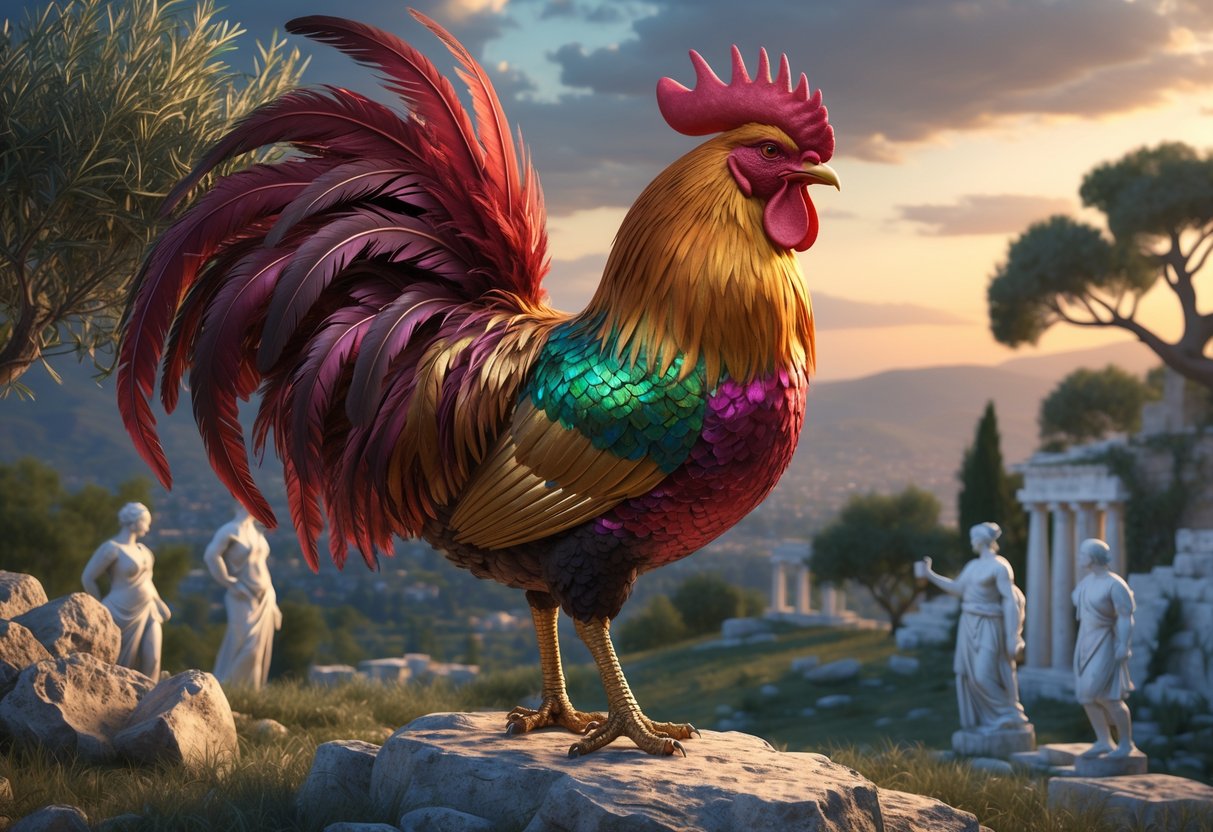
In Greek myth, Alectryon was a young soldier who Ares turned into a rooster for sleeping on guard duty. This story explains why roosters crow at dawn—they’re stuck forever announcing Helios’s arrival.
The Transformation of Alectryon
Alectryon’s name literally means “rooster” in Greek. He hung out with Ares, joining him at parties and during love affairs.
Ares put Alectryon on guard outside his bedroom door, making him watch for Helios, the all-seeing sun god who might catch Ares’s secret.
But Alectryon nodded off. Helios noticed the lovers right away and told Hephaestus, Aphrodite’s husband.
Ares didn’t waste any time with punishment. He turned his friend into a rooster, not just out of anger but as a kind of permanent reminder.
As a rooster, Alectryon had to announce the sun’s arrival every day. Crowing at dawn became his way of apologizing to Ares, even though it couldn’t fix what he’d done.
Ares and Aphrodite’s Story
Ares and Aphrodite’s affair was one of the juiciest scandals in Greek mythology. Ares, the god of war, fell hard for Aphrodite, the goddess of love and beauty.
Their romance was passionate and totally forbidden. After all, Aphrodite was married to Hephaestus, the god of fire and metalwork.
Ares worried about getting caught by Helios, who saw everything from the sky. Helios had a reputation for exposing the gods, especially to wronged spouses like Hephaestus.
When Helios finally caught them, he told Hephaestus right away. Hephaestus made a clever invisible net to trap the couple the next time they met.
The gods humiliated the trapped lovers in front of everyone. This scandal became legendary, showing just how messy forbidden love could get.
Symbolism of Helios and the Dawn
Helios played the role of the ever-watchful witness in this story. As the sun god, he traveled across the sky every day, seeing everything that happened.
His discovery of the affair brought divine justice and proved that no one could hide from the sun’s gaze.
The rooster’s crowing at dawn took on deep meaning in Greek culture. It stood for:
- Vigilance against moral slips
- Warning of coming judgment
- Redemption by staying loyal
The Greeks thought roosters were sacred to Helios. Their reliable dawn calls reminded everyone that the sun god was always watching.
This myth acted as an aetiological tale—a story that explains something in the natural world. It answered why roosters crow at sunrise, tying an everyday sound to divine punishment and eternal duty.
Rooster Symbolism Across Cultures
Roosters carry a lot of meaning across different cultures and eras. As the bringers of dawn, they’re tied to ideas of renewal, and their bold attitude makes them stand for masculine strength and watchful protection.
Symbol of Dawn and Renewal
Roosters naturally crow at sunrise, making them a universal sign of new beginnings. In ancient Egypt, people linked roosters to the sun god Ra—they saw the bird as a symbol of the daily cycle of death and rebirth.
Greek myths connect roosters to Apollo, the god of light and prophecy. Their morning call worked as a spiritual wake-up. Over in Rome, people thought of roosters as guards against evil during the risky hours between night and day.
Farmers everywhere still treat the rooster’s crow as nature’s alarm clock. This daily rhythm forges a strong link between the bird and humanity’s sense of renewal. The rooster reminds us every dawn is a new shot at things.
Buddhists see roosters as symbols of mindfulness and punctuality. Their steady crowing stands for the discipline needed to grow spiritually. In Christian symbolism, roosters represent being watchful and spiritually awake.
Masculinity and Male Energy
Roosters strut around showing off masculine energy with their proud stance and territorial behavior. Their flashy feathers and bold walk give off a natural authority that people have admired for ages.
In Chinese astrology, folks born in the Year of the Rooster are said to have courage, honesty, and leadership—traits that fit the bird’s confident and protective nature.
Hindu stories tie roosters to the warrior goddess Durga, highlighting their role in battle and protection. A rooster’s fearless defense of its turf makes it a perfect symbol of courage.
Lots of folk tales show clever roosters outsmarting bigger predators. These stories celebrate brains and bravery together. It’s not just about being tough—the rooster’s courage goes beyond size.
Vigilance and Protection
Roosters act as natural guardians on farms everywhere. They’re alert and territorial, so they protect livestock and property pretty well.
People have used rooster images on military standards since ancient Rome to represent vigilance in battle. The bird’s sharp awareness made it a symbol for staying on guard.
In many folk stories, roosters scare off evil spirits with their crowing. This belief pops up from Europe to Asia—folks saw the rooster as a protector against bad stuff lurking in the dark.
Farmers rely on roosters to sound the alarm when predators are near. That practical role just cements their reputation as guardians. Roosters give up sleep to keep watch, showing real dedication to the flock.
Rooster in the Chinese Zodiac
The Rooster sits in the tenth spot of the Chinese zodiac’s 12-year cycle. Years like 1969, 1981, 1993, 2005, 2017, and 2029 all fall under this sign. People born in these years pick up certain personality traits, which get shaped further by five elemental influences. The Rooster’s symbolism also weaves into lots of Chinese traditions and superstitions.
Traits of Those Born in the Year of the Rooster
Folks born in the Year of the Rooster usually share some stand-out qualities. They’re confident, not shy about speaking up, and often take the lead when things need to get done.
Core personality traits:
- Hardworking and diligent
- Honest, sometimes blunt
- Detail-oriented
- Outgoing and social
- Organized and efficient
Roosters tend to shine in leadership positions. Their punctuality mirrors the rooster’s early crowing, so you can usually count on them to show up on time.
Sometimes, though, their confidence comes off as arrogance. Rooster symbolism reminds us there’s a fine line between healthy pride and vanity. Many Roosters wrestle with perfectionism, setting the bar high for themselves and others.
In relationships, Roosters stay loyal and protective. They put honesty first, but their straightforwardness can sting if you’re sensitive.
Five Elements and Rooster Types
Chinese astrology pairs each zodiac year with one of five elements, creating unique Rooster personalities every 60 years.
| Element | Years | Key Characteristics |
|---|---|---|
| Metal Rooster | 1921, 1981 | Determined, organized, sometimes a bit rigid |
| Water Rooster | 1933, 1993 | Intuitive, adaptable, great communicators |
| Wood Rooster | 1945, 2005 | Creative, compassionate, team players |
| Fire Rooster | 1957, 2017 | Energetic, passionate, born leaders |
| Earth Rooster | 1969, 2029 | Practical, reliable, methodical |
Metal Roosters chase their goals with focus and drive, but they can get stuck in their ways.
Water Roosters mix confidence with emotional smarts. They’re good at reading people and adjusting their approach.
Fire Roosters bring the most dramatic energy of all. They’re natural performers and great speakers, but they might struggle with patience sometimes.
Cultural Superstitions and Traditions
Traditional Chinese culture wraps the Rooster in all sorts of beliefs and customs. When Chinese New Year rolls around, rooster images pop up everywhere, signaling hopes for prosperity and good luck in the months ahead.
Families often set rooster figurines near their front doors. They believe the rooster’s bold spirit keeps evil and negativity at bay.
Common rooster-related traditions:
- Eating chicken during rooster years for prosperity
- Giving rooster-themed gifts to newborns
- Decorating homes with red and gold rooster images
- Timing important events to rooster hours (5-7 AM)
In some places, people pay close attention to the rooster’s crowing. That very first crow at dawn? Folks say it’s lucky, especially if you’re starting a new business that day.
When it comes to marriage, Roosters supposedly mesh best with Oxen and Snakes, but not so much with Rabbits and Dogs. Some couples still check these old charts before tying the knot, though honestly, opinions on this stuff vary a lot.
The Year of the Rooster even shapes how parents pick names, leaning toward ones that reflect brightness, alertness, or even golden colors.
Rooster in Religion and Spirituality
Roosters show up in major religions as symbols of vigilance, courage, and spiritual awakening. Whether it’s biblical stories or Hindu legends, these birds seem to carry a lot of spiritual weight.
Rooster in the Bible
The rooster plays a surprisingly big role in Christianity’s famous stories. Jesus told Peter, “Before the cock crows, you’ll deny me three times.”
That’s exactly what happened the night Jesus was arrested. Peter denied him three times, and just as dawn broke, the rooster crowed.
That crow hit Peter hard. It forced him to face what he’d done.
Key biblical meanings:
- Betrayal and forgiveness – Peter’s denial and then redemption
- Divine timing – Prophecy fulfilled right on schedule
- Awakening – Realizing one’s own failures
Early Christians started using the rooster as a symbol of vigilance. It reminded them to stay awake and true to their faith.
Christian Symbolism and Stories
Christian tradition took the rooster’s meaning even further. For many, it stands for courage in spiritual battles and sticking to your beliefs.
Roosters turned up on church weathervanes in early Christian art. These were meant to remind everyone to stay alert in their faith.
The rooster’s crow at dawn became a symbol for Christ’s resurrection. Just like the rooster calls in the morning, Christ brought new life.
Christian rooster symbolism includes:
- Resurrection – Triumph over darkness and death
- Vigilance – Staying sharp to spiritual threats
- Courage – Defending faith boldly
Plenty of Christians see the rooster as a guardian. Its crow chases away evil spirits and anything dark that lurks at night.
Jewish and Hindu Perspectives
Jewish tradition picks up on the rooster’s sense of timing, seeing it as a sign of God’s order in the world.
During Yom Kippur, some Jewish communities used roosters in kapparot rituals. The bird supposedly carried away sins and brought atonement.
Roosters crow loudly in Hindu mythology too. Lord Skanda, the god of war, carries a rooster symbol for masculinity and courage.
Hindu rooster meanings:
- Solar connection – Linked to sun worship
- Masculine power – Strength and warrior spirit
- Divine protection – Guardian against evil
Buddhist zodiac traditions include the rooster as well. It stands for punctuality, diligence, and mindful awareness.
Rooster as a Spirit, Totem, and Power Animal

The rooster connects people to spiritual awakening, fierce protection, and bold self-expression. These birds encourage us to act with courage, stay alert, and announce ourselves to the world.
Rooster Spirit Animal Meanings
If the rooster shows up as your spirit animal, it’s probably nudging you about timing and courage. Its crow at dawn is a wakeup call for new beginnings.
Key spiritual meanings include:
- Awakening and awareness – urging us to rise
- Divine timing – knowing when to jump in
- Spiritual vigilance – noticing opportunities
- Courage in challenges – facing fears head-on
The rooster spirit animal often comes when you need to get past anxiety. It helps you deal with fears that threaten your sense of safety.
Some people notice the rooster when they’re going through spiritual changes. Its boldness pushes us to embrace our spiritual side, even if we’re unsure.
Rooster energy teaches us to protect what’s important. It helps us stand tall, even when life gets tough.
Rooster Totem Attributes
People born under the rooster totem tend to show the same traits as this proud bird. You’ll notice leadership and determination right away.
Primary totem characteristics:
- Natural vigilance – always tuned in
- Bold self-expression – not afraid to be seen
- Protective instincts – fiercely guarding loved ones
- Time awareness – understanding life’s rhythms
Rooster totem folks often become the “alarm clock” for their group. They wake others up to what matters.
Their bright feathers stand for confidence. These people don’t shy away from attention and usually express themselves with flair.
Fertility and new beginnings run strong in this totem. Many cultures see the rooster as sacred, tied to fresh starts and creativity.
Rooster totem people usually show real bravery when it comes to protecting their “flock”—family, friends, or community.
Rooster Power Animal Symbolism
When you call on rooster power animal energy, you’re asking for more awareness and protection. This solar, masculine symbol brings themes of sexuality, watchfulness, and resurrection.
Power animal gifts:
- Enhanced alertness – spotting trouble and chances
- Confident communication – speaking up without fear
- Leadership strength – guiding others through tough times
- Spiritual resurrection – bouncing back from hardship
The rooster power animal helps us tune into our “inner alarm.” We start noticing changes in energy and timing in our lives.
Leaders especially benefit from this energy. The rooster’s authority helps us earn respect and protect others fairly.
When you need courage to speak honestly, the rooster lends its voice. It teaches us to celebrate our wins without pretending to be humble.
The rooster’s link to sunrise brings a sense of resurrection. We get back up after setbacks, ready to face the world again.
Rooster Symbolism in Art and Tattoos
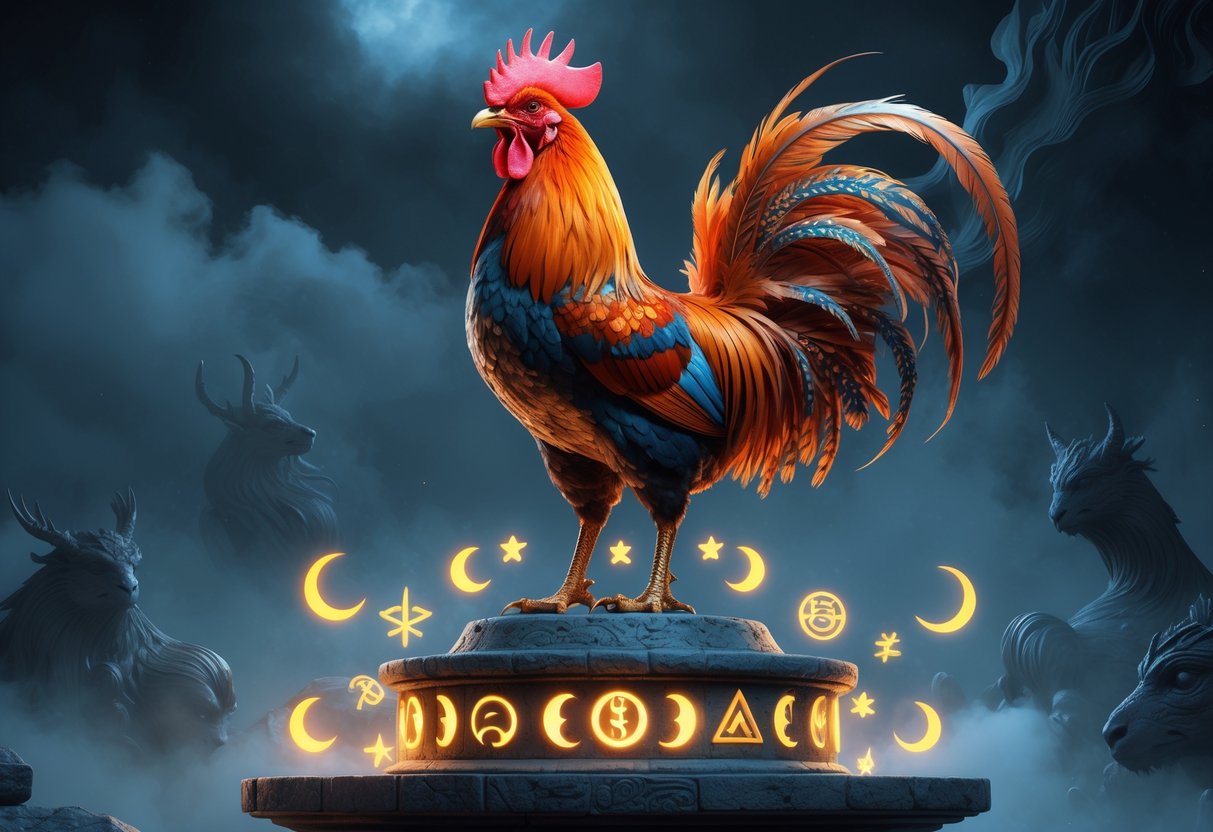
Roosters have inspired artists and tattoo lovers for ages, carrying meanings like courage, new beginnings, protection, and spiritual strength. You’ll spot these birds in everything from ancient Greek pottery to modern ink.
Rooster Tattoo Meanings
Rooster tattoos stand for powerful qualities and beliefs. They’re about courage, honesty, and beating back the darkness.
Lots of people pick rooster tattoos to show they’re starting fresh. The rooster’s morning crow is a natural symbol for hope and new beginnings.
Common rooster tattoo meanings include:
- Courage and bravery in tough times
- Protection from bad vibes
- Loyalty and honesty in relationships
- Vigilance and alertness
- Connection to the sun and light
Tattoo placement makes a difference. On the chest or upper arm, a rooster stands for bravery. On the thigh or leg, it’s about strength and vitality.
Culture matters, too. In Chinese tradition, rooster tattoos bring luck. Greek roots tie them to Apollo, light, and victory.
Artistic Depictions Through History
Artists have painted, sculpted, and carved roosters for thousands of years. Ancient Greeks often painted them as sacred to Ares, the war god.
Roosters appear in all sorts of art:
- Weather vanes on rooftops
- Religious paintings and statues
- Folk art
- Modern works
Shinto shrines in Japan display roosters as sacred birds that purify the land. French and Portuguese artists use them as proud national symbols.
Norse mythology inspired artists to show the golden rooster Gullinkambi on Yggdrasil, the world tree. It stands for vigilance and warning.
Celtic art paints roosters as guides for brave souls. West African Yoruba art uses them as spiritual strength symbols in rituals.
The Rooster in Folklore and Superstition
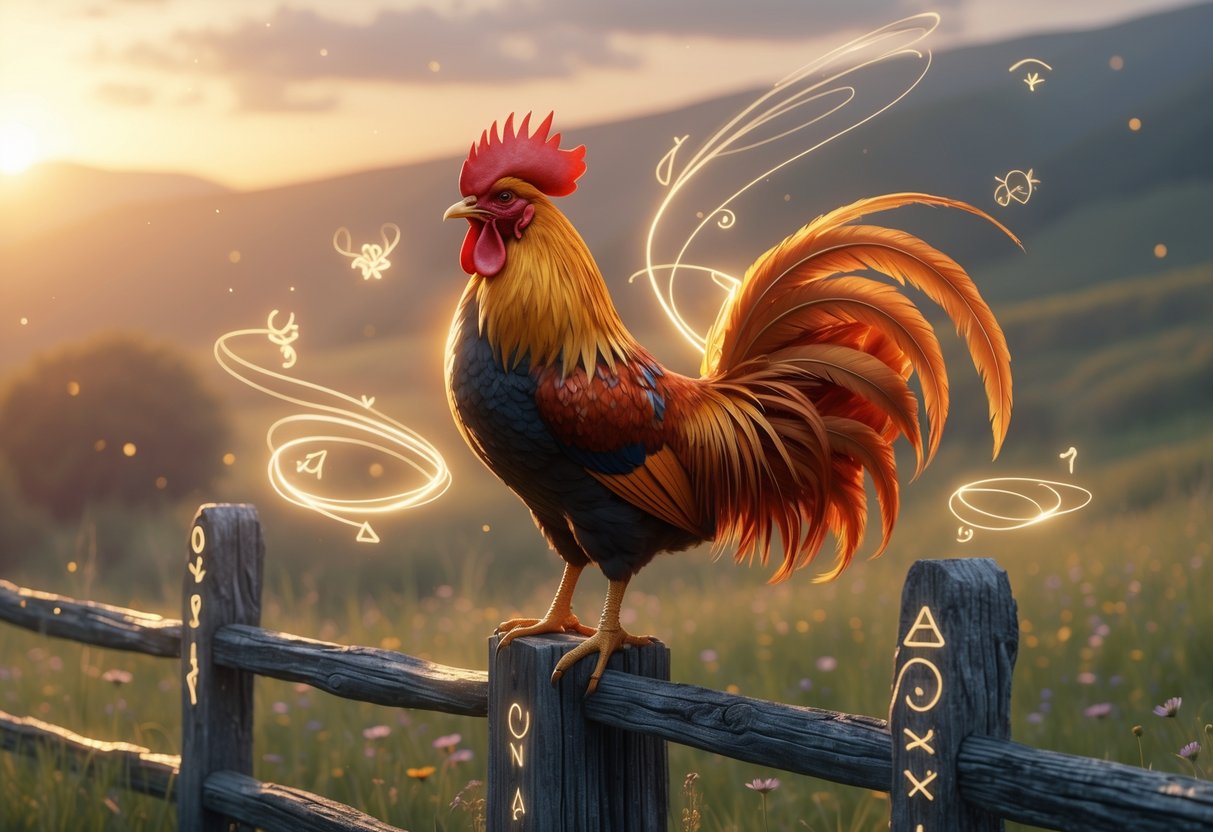
Roosters pop up in folk tales as clever heroes and moral guides. People have long believed they can chase away evil spirits and even predict the future.
Folk Tales and Moral Lessons
Rooster tales usually teach big lessons through clever storytelling. “The Rooster and the Fox” is a classic: a smart rooster outwits a hungry fox, proving brains beat brawn.
In European stories, the rooster often wins as the underdog by using its wits. The message? Smarts matter more than size or strength.
Japanese folklore claims roosters can predict disasters by changing their crowing. Villagers listened closely each morning, hoping for warnings about earthquakes or floods.
Common themes in rooster folk tales include:
- Cleverness over brute strength
- The need to stay alert
- Loyalty to loved ones
- Telling the truth, even if it’s tough
Omens and Magical Beliefs
A lot of people see rooster behavior as a kind of fortune-telling. If a rooster crows at weird times, something big might be coming.
British folklore warns that a rooster crowing three times before dawn signals death in the house. Folks took these signs seriously and braced for trouble.
Popular rooster omens include:
- Crowing at midnight = visitor coming soon
- Silent roosters = bad weather on the way
- White roosters = powerful fortune tellers
- Roosters refusing to crow = danger close by
Some farmers kept special “oracle roosters” just for predicting the future. These birds got extra care and lived apart from the rest.
Protection from Evil
Roosters have a reputation as protectors against darkness. Their loud crowing supposedly scares off demons, witches, and evil spirits who hate noise and light.
European villages often put rooster weathervanes on church towers. People hoped these metal birds would watch over everyone while they slept.
Some folks carried rooster feathers for protection on dangerous trips. Sailors brought rooster charms on ships to keep storms and sea monsters away.
Traditional protection methods using roosters:
- Placing feathers above doors
- Burying rooster bones in garden corners
- Drawing rooster signs on barns and houses
- Keeping a black rooster just for safety
Belief in the rooster’s powers stuck around for a long time, especially in rural places where old superstitions held on.
Rooster and Agricultural Societies
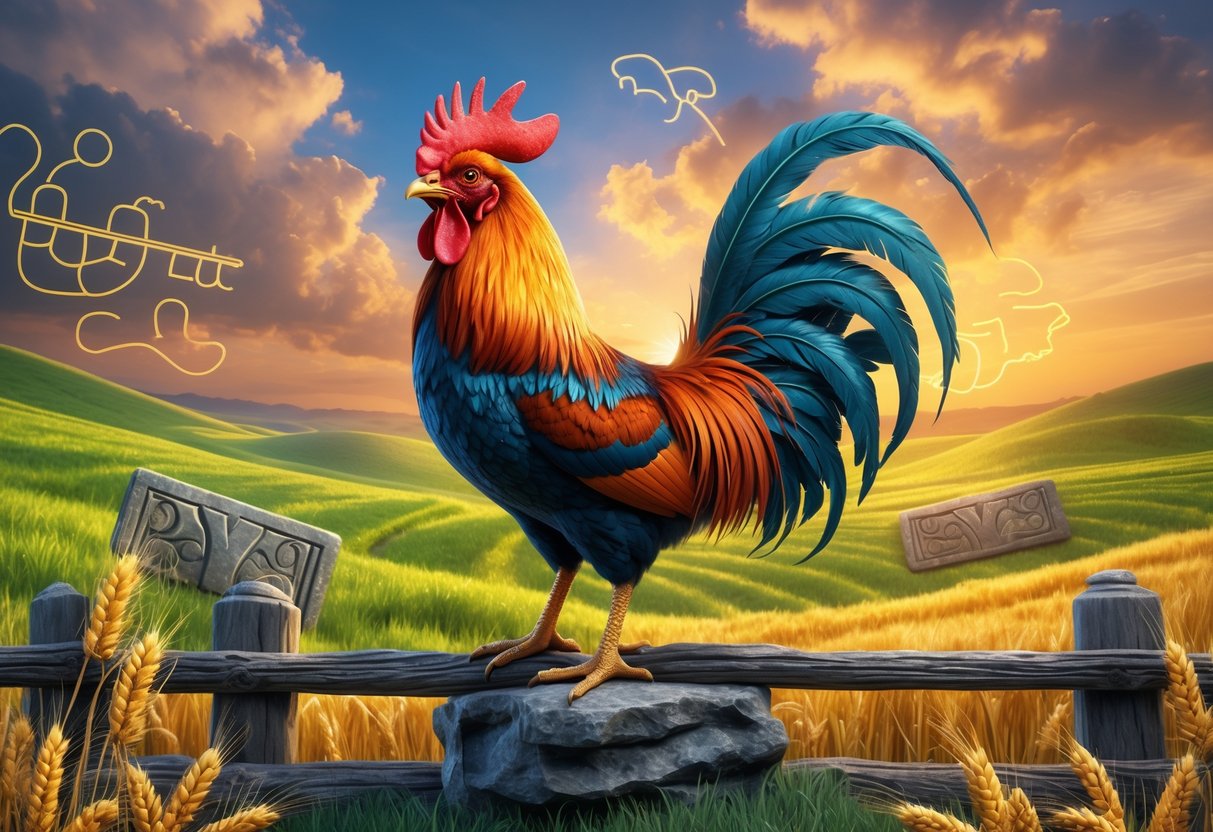
Roosters became vital to farming communities, acting as living alarm clocks and flock guardians. Over time, people started seeing them as symbols of fertility, abundance, and the agricultural cycle itself.
Role in Farming Traditions
Roosters acted as living alarm clocks in farming communities all over the world. When dawn broke, their crows nudged farmers to get moving and start the day.
People mentioned roosters in ancient farming almanacs and old texts. Farmers watched their daily routines, using those patterns to decide when to plant and harvest.
Practical functions included:
- Guarding hens from predators
- Keeping flock order
- Waking up farm workers
- Breeding strong chicken stock
Plenty of farming cultures came up with their own rooster-keeping customs. Some even bred certain roosters just for louder crows or for their perfect timing.
In Chinese agricultural villages, rooster symbolism stood for five farming virtues. People valued the rooster’s reliability at dawn, its courage against threats, and its fierce protection of the flock.
Japanese farmers tied roosters to Amaterasu, the sun goddess. They believed a rooster’s crow could invite good weather and help bring in a rich harvest.
Symbol of Fertility and Abundance
Roosters came to symbolize fertility and abundance for many farming societies. Their boldness and protective instincts just seemed to fit.
Fertility symbolism appeared in:
- Harvest festival decorations and ceremonies
- Wedding rituals in rural communities
- Blessings for new crops
- Livestock protection charms
Farmers often placed rooster images on barns and grain stores. They hoped these symbols would guard stored crops and breeding animals.
Chinese feng shui practices used rooster figures to attract prosperity on farms. A red rooster meant protection from fire, while a white one kept away bad spirits.
European farmers often made roosters part of their spring planting rituals. The bird stood for the masculine energy needed to fertilize crops and bring good yields.
Some communities held rooster fights or contests during agricultural festivals. These events highlighted the bird’s strength and tied it to hopes for a plentiful harvest.
Male Energy and Courage in Rooster Lore
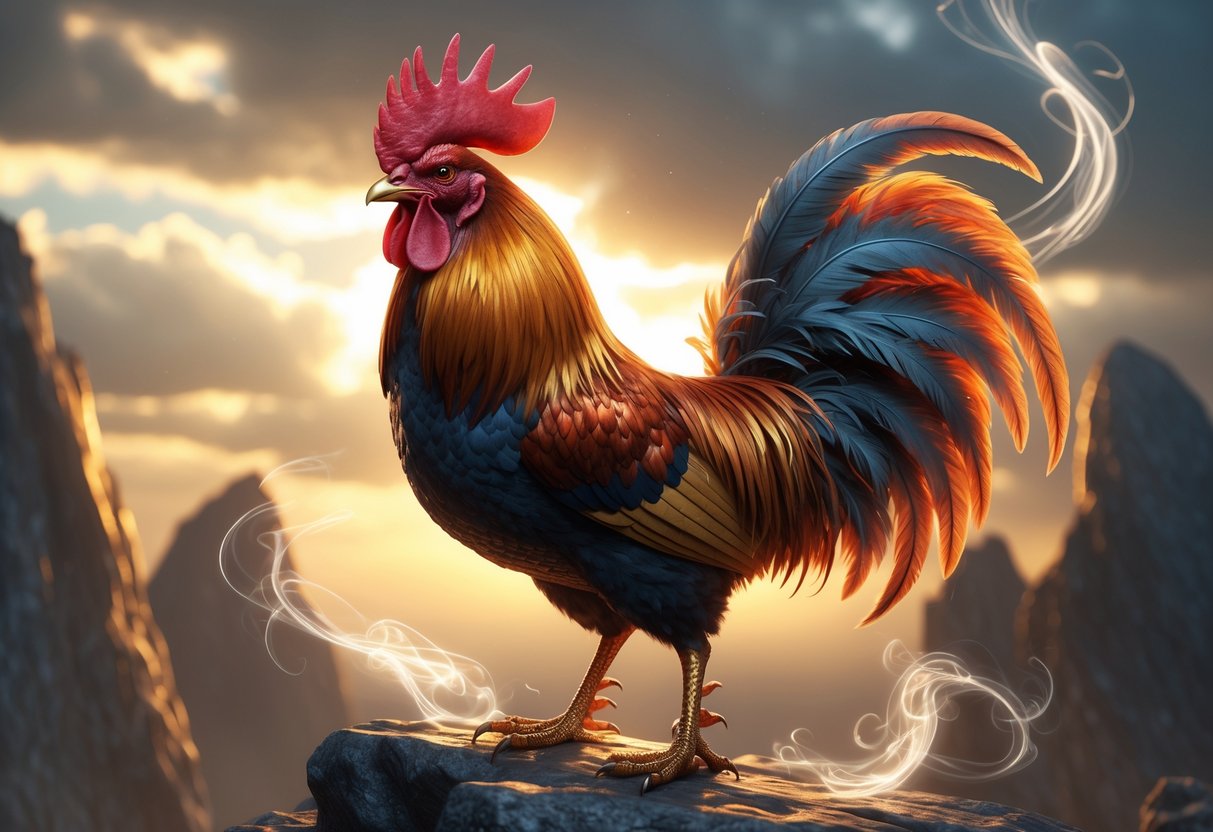
Across the world, people have seen roosters as symbols of masculine power and boldness. These birds show off their energy by defending their territory and protecting their flock with real grit.
Representations of Virility
The rooster is basically nature’s show-off when it comes to masculine energy. You can see their dominance in how they behave around hens—always loud, always strutting.
Back in ancient times, people admired virility and productivity above almost everything else. Roosters earned their spot as the animal kingdom’s top fertility symbol.
Key masculine traits roosters represent:
- Territorial dominance
- Fierce protection instincts
- High fertility
- Bold self-expression
Chinese mythology credits roosters with five masculine virtues: knowledge, military skill, courage, kindness, and trustworthiness. These became the blueprint for ideal masculinity in traditional Chinese culture.
Their bright feathers and proud stance made roosters obvious symbols of power. People saw them as natural leaders, representing strength and authority.
Rooster as a Bravery Icon
Roosters face down threats much bigger than themselves without hesitation. That’s why so many cultures made them symbols of bravery.
Chinese stories tell of roosters sacrificing themselves to save their owners. These tales highlight their loyalty and fighting spirit.
Courage representations in various cultures:
- Greek mythology: Linked to Ares, god of war
- Indian tradition: On Lord Murugan’s flag, showing victory over ignorance
- European folklore: Drives out devils and evil spirits
- Chinese culture: Wards off evil
People saw the rooster’s crow as a sign of courage. That call slices through darkness, announcing that evil has lost and daylight is here.
Military groups sometimes put roosters on their flags and banners. The bird’s image inspired soldiers to fight bravely and never back down.
The Rooster in Modern Culture
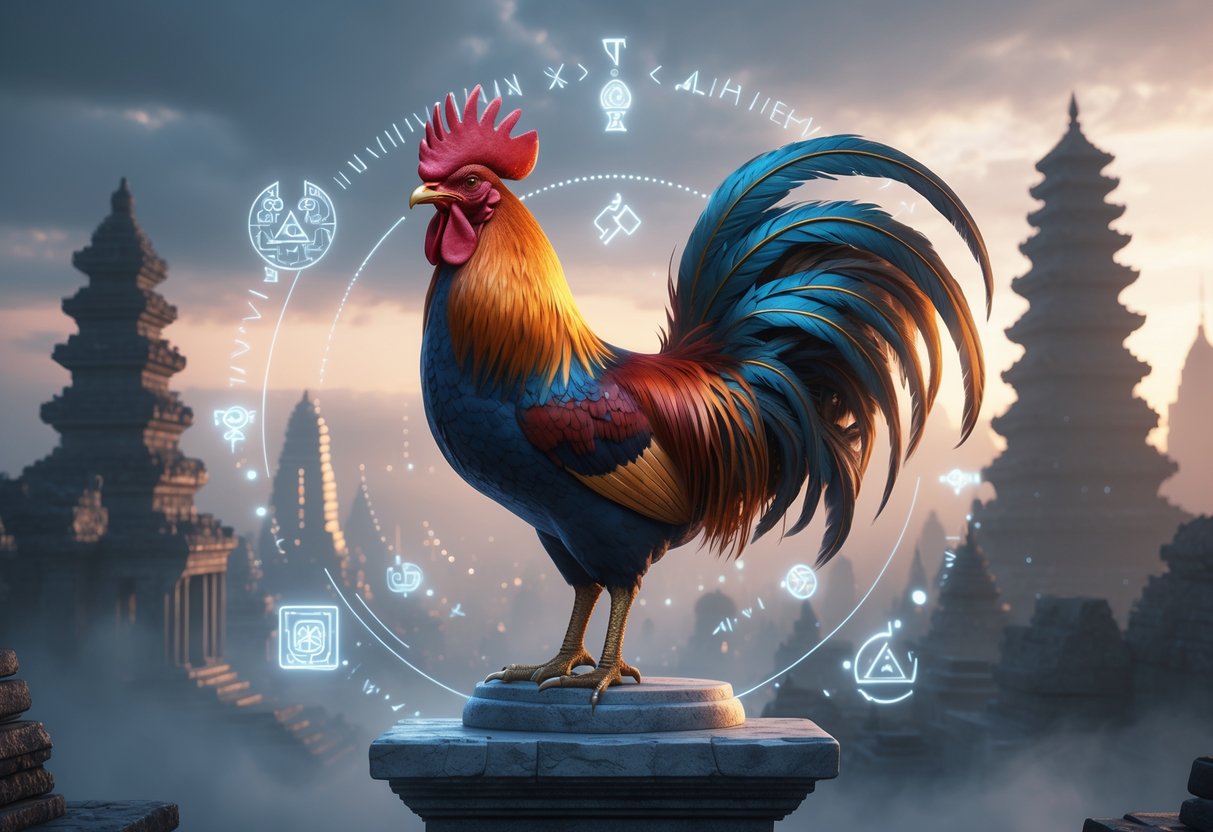
Rooster symbolism still pops up everywhere today, from national emblems to zodiac parties. Modern culture has latched onto the rooster as a sign of courage, new beginnings, and constant vigilance.
Contemporary Symbolism
The rooster hasn’t lost its place in modern nations and culture. France, for example, uses the rooster as a national symbol—standing for courage, pride, and honesty. You’ll see it on sports jerseys and official seals.
Portugal does something similar. The Barcelos rooster became a national mascot, showing up on souvenirs and all sorts of cultural displays.
Brands use rooster logos to suggest reliability and that “fresh start” feeling. Even now, weather vanes shaped like roosters still perch on rooftops, keeping their old role as guardians and timekeepers alive.
Modern rooster symbolism includes:
- National pride
- Morning freshness in ads
- Alertness and protection
- Strength and confidence
- New beginnings
Rooster emojis and memes have caught on in social media, usually to mean early mornings, wake-up calls, or starting something new.
Cultural Celebrations and Festivals
Every twelve years, the Year of the Rooster brings out big celebrations in Chinese culture. People born in rooster years (like 2017, and next up is 2029) are said to be confident, honest, and natural leaders.
During those years, Chinese New Year parties feature rooster-themed decorations, dances, and foods. Red roosters show up on lanterns and gifts, believed to bring luck and keep away bad spirits.
In Portugal, festivals celebrate the Barcelos rooster with parades and crafts. The legend says a rooster proved a man’s innocence by crowing, so now it stands for justice.
Key rooster festivals include:
- Chinese New Year (rooster years)
- Portuguese Barcelos Festival
- French cultural events
- Agricultural fairs
Modern farm fairs still honor roosters with contests and displays. These gatherings help city folks reconnect with rural traditions and keep the rooster’s cultural significance alive.
Frequently Asked Questions
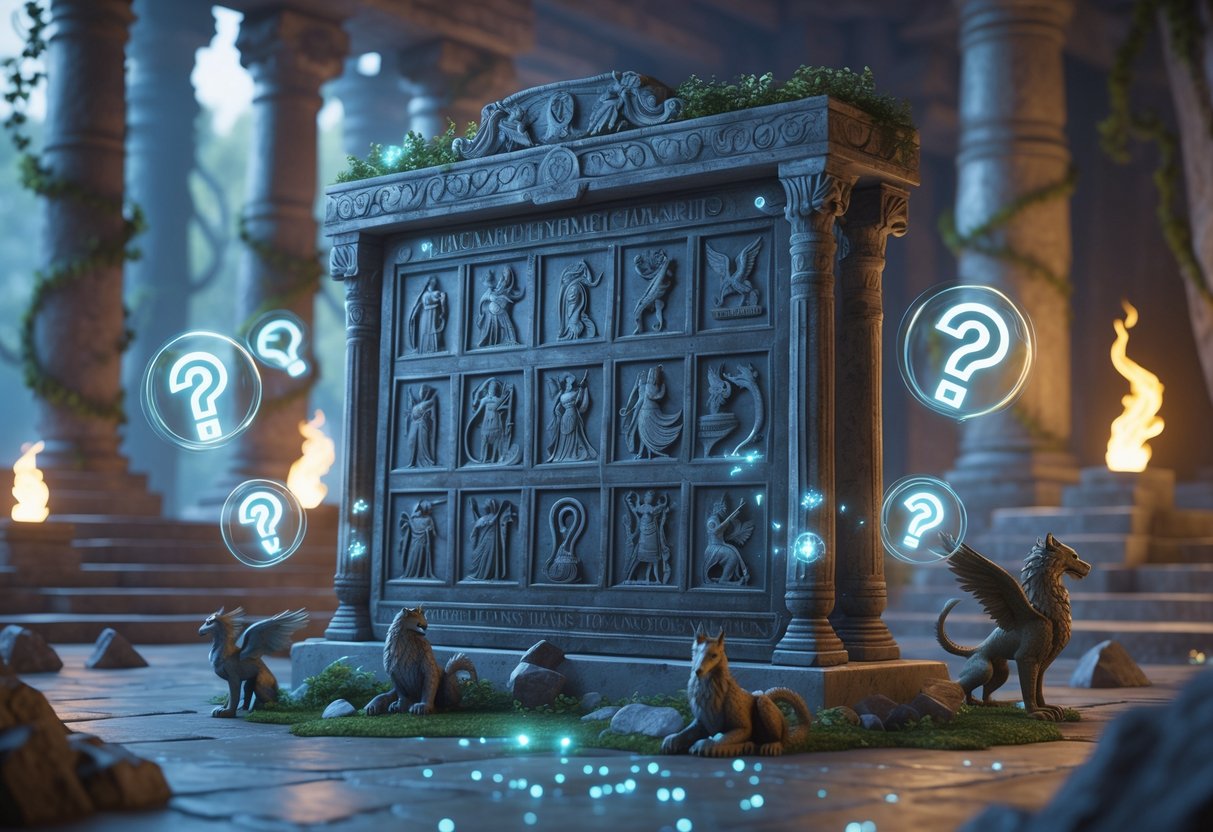
Roosters show up in myths from all over, usually as symbols of courage, dawn, or protection. Let’s dig into a few questions about their place in mythology and the other legendary creatures that share the spotlight.
What is the story behind the mythical creature known as the cockatrice?
The cockatrice is a strange beast from European legend, with a rooster’s head and legs but a dragon’s body and tail. People once believed it was so deadly that a glance or a breath could kill.
Stories say a cockatrice hatches when a cockerel sits on a serpent’s egg. This odd mix gave it both earthly and supernatural powers. Its rooster traits stood for vigilance and dawn, while the dragon parts added a sense of danger.
Heroes in old tales often beat cockatrices with mirrors. The creature would kill itself by looking at its own deadly reflection. You’ll find this story in plenty of medieval books and bestiaries.
Can you tell me about the role of chickens in various mythological tales?
Chickens and especially roosters play big parts in myths from all over. In Norse stories, the rooster Gullinkambi wakes the gods for the last battle, Ragnarök.
Celtic legends have roosters guiding souls to the Otherworld. Their crow marks the line between day and night, or even life and death. A lot of Irish tales talk about magical roosters that can speak prophecies or warnings.
In Hindu tradition, some gods ride roosters as sacred mounts. The bird stands for the triumph of light over darkness. Japanese Shinto beliefs also tie roosters to the sun goddess Amaterasu, whose return brings back the daylight.
Who is considered the god of chickens in Greek mythology?
There isn’t a Greek god just for chickens, but a few deities do have strong rooster connections. Ares, the war god, often appears with a rooster as his sacred animal—a sign of courage and vigilance.
Apollo, god of the sun and prophecy, also claimed the rooster. Its crow at dawn fit perfectly with Apollo’s solar role. Greeks thought roosters could even predict the future.
Hermes sometimes shows up with roosters in art and stories. As the gods’ messenger, Hermes shared the rooster’s job as an announcer. The bird’s quickness and alertness matched Hermes’ style.
Could you elaborate on the significance of daggers in mythological narratives?
Daggers in myths usually stand for swift justice, sacrifice, or the thin line between life and death. Many cultures used ceremonial daggers for rituals or divine punishment.
Celtic stories feature magical daggers that never miss or can cut through anything. These weapons often belonged to heroes or gods and symbolized their power. Sometimes, the daggers would even return to their owners like boomerangs.
Greek myths use daggers in moments of betrayal or change. Their small size made them perfect for sneaky attacks. These stories remind us how fate can turn on a dime—or how danger can hide in plain sight.
What are some of the mythical races featured in ancient tales and lore?
Ancient myths are full of supernatural races besides gods and humans. Elves appear in Norse and Germanic stories as magical craftsmen with long lives.
Dwarves show up just as often, known for their skill in mining and metalwork. They made powerful weapons and treasures for gods and heroes, and their underground homes held ancient secrets.
Giants—or titans—represented the raw forces of nature. These beings often fought the gods in epic battles that shaped the world. Some myths describe different kinds of giants, like frost or fire giants, each with their own powers.
How is homosexuality represented and interpreted in Greek mythological stories?
Greek mythology features plenty of same-sex relationships among gods, heroes, and mortals. Honestly, these connections just show up in the stories as part of everyday life, not some big, shocking twist.
Take Apollo, for example. He loved Hyacinthus, but things took a tragic turn when Apollo accidentally killed him during a discus game.
Then there’s Zeus, who turned into an eagle and swooped down to carry off Ganymede—a strikingly handsome young man. Ganymede ended up serving as cupbearer to the gods. Ancient writers told these stories matter-of-factly, without tacking on any moral lessons.
The Greeks actually recognized different kinds of same-sex relationships. One common type was the mentor-student bond between older and younger men. People in Greek society generally accepted these bonds, which mixed romance, education, and a bit of guidance.

